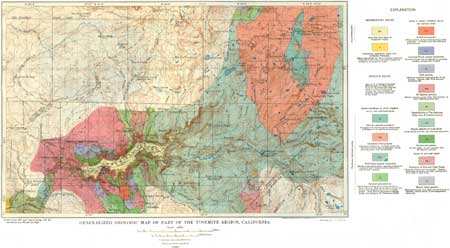
|
Geological Survey Professional Paper 160
Geologic History of the Yosemite Valley |
APPENDIX
THE GRANITIC ROCKS OF THE YOSEMITE REGION
By FRANK C. CALKINS
GENERAL CHARACTER OF THE ROCKS
The granitic rocks of the Yosemite region form part of the great central mass of igneous rooks (the batholith) of the Sierra Nevada, whose general character has been explained on page 25. They consist of materials that have surged up in a molten state from the interior or the earth and that have crystallized under a confining roof of other rocks—the slate, quartzite, marble, and volcanic rocks of whose buckled and folded beds the ancestral Sierra ridges of Cretaceous time were made. (See table of geologic time divisions, p. 23.) That the granitic rocks are now exposed to view over large areas is due to the fact that in the course of periods aggregating about 100,000,000 years the roof rocks were removed by the slow wearing action of streams and other eroding agents. The ancestral Sierras, once presumably thousands of feet in height, have vanished, only their roots remaining in the bodies of metamorphic rock that cover the lower slope and the crest of the present range.
In the Yosemite region a few small remnants of the ancient roof rocks remained preserved here and there, but these have been sufficiently described on page 26 and therefore will not be mentioned here.
The batholith of the Sierra Nevada is composite that is, it is made up of a number of distinct bodies of igneous rock, each of which differs somewhat from its neighbors in mineral composition and represents a separate upflow of molten material. Of these component bodies many are of great extent, their areas at the surface being measured in hundreds of square miles. The uplands flanking the Yosemite Valley are made up almost wholly of such large intrusive bodies. The valley itself, on the contrary, crosses an area where many small intrusive bodies and narrow projections from the larger ones intersect each other in an intricate manner. Indeed, the rocks of the middle and lower parts of the Yosemite Valley are varied in composition and complex in their relationships to a degree exemplified in few areas of similar extent that have been described or mapped in detail. This complexity of the valley area, as compared with the relative simplicity of the surrounding areas, is clearly shown on the geologic map (pl. 51), even though the limitations imposed by the scale require the omission of many of the lesser intrusive bodies.

|
| PLATE 51.—GENERALIZED GEOLOGIC MAP OF PART OF THE YOSEMITE REGION, CALIFORNIA. (click on image for an enlargement in a new window) |
The species of rock represented in the Yosemite region range from nearly black hornblende gabbro through successively lighter-colored diorite, granodiorite, quartz monzonite, and biotite granite to nearly white alaskite. No variety differs markedly from the most closely similar rock that can be shown to be of distinctly different age, and all, considered collectively, exhibit a strong family resemblance, which suggests that they may have welled up from a common reservoir of molten rock within the earth in rather quick succession—that is, within a period that was brief in the geologic sense.
The great bulk of the granitic rocks in the Yosemite region belong to two series of intrusions, the members of each series exhibiting an especially close relationship to one another. These may be termed the biotite granite series of the Yosemite Valley and the Tuolumne intrusive series. The former includes the El Capitan and Taft granites and several minor intrusive masses confined mostly to the lower and middle parts of the valley; the latter includes the Sentinel granodiorite, Half Dome quartz monzonite, Cathedral Peak granite, and Johnson granite porphyry—formations which extend in large bodies from the upper half of the Yosemite Valley northward to the Tuolumne River and northeastward into the High Sierra. (See pl. 51.) In addition there are several kinds of rock, not assignable to either of these series, that occupy small areas in the lower Yosemite Valley and along the Merced Gorge—notably hornblende gabbro, the granodiorite of the Gateway, the granite southwest of the Gateway, and the granodiorite at El Portal; and at the upper boundary of the Yosemite region, in the Clark Range, are the Mount Clark granite and the porphyritic rocks of Gray Peak and Red Peak.
As shown by the geologic map (pl. 51), the rocks forming the bodies of greatest extent are the El Capitan granite, the Sentinel granodiorite, the Half Dome quartz monzonite, and the Cathedral Peak granite. The other rocks are relatively of small extent.
| <<< Previous | <<< Contents >>> | Next >>> |
pp/160/appendix-sec1.htm
Last Updated: 28-Nov-2006